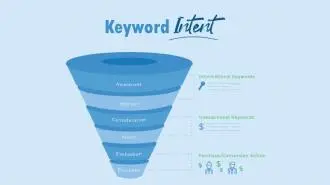Summary / TL;DR
Search intent in SEO refers to the underlying goal behind a user's search query, such as seeking information, navigating to a site, or making a purchase. The article outlines four main types: informational, navigational, transactional, and commercial investigation. Understanding and targeting these intent types enables businesses to optimise content, improve rankings, and increase conversions. For example, transactional searches often use keywords like 'buy' or 'discount', while informational searches use phrases like 'how to' or 'what is'. Tools like Google Keyword Planner and Ahrefs help identify high-intent keywords linked to user motives, improving SEO effectiveness. Keyword choices must also consider regional variations in spelling and terms, especially for global markets.
SEO is well-regarded for its ability to boost website traffic. It’s a powerful tool when used effectively.
You can optimise your site to attract potential customers with proper keyword research. The most effective use of keyword research tools to identify these search terms to identify these keywords, the higher your chances of ranking on the search engine results pages (SERPs).
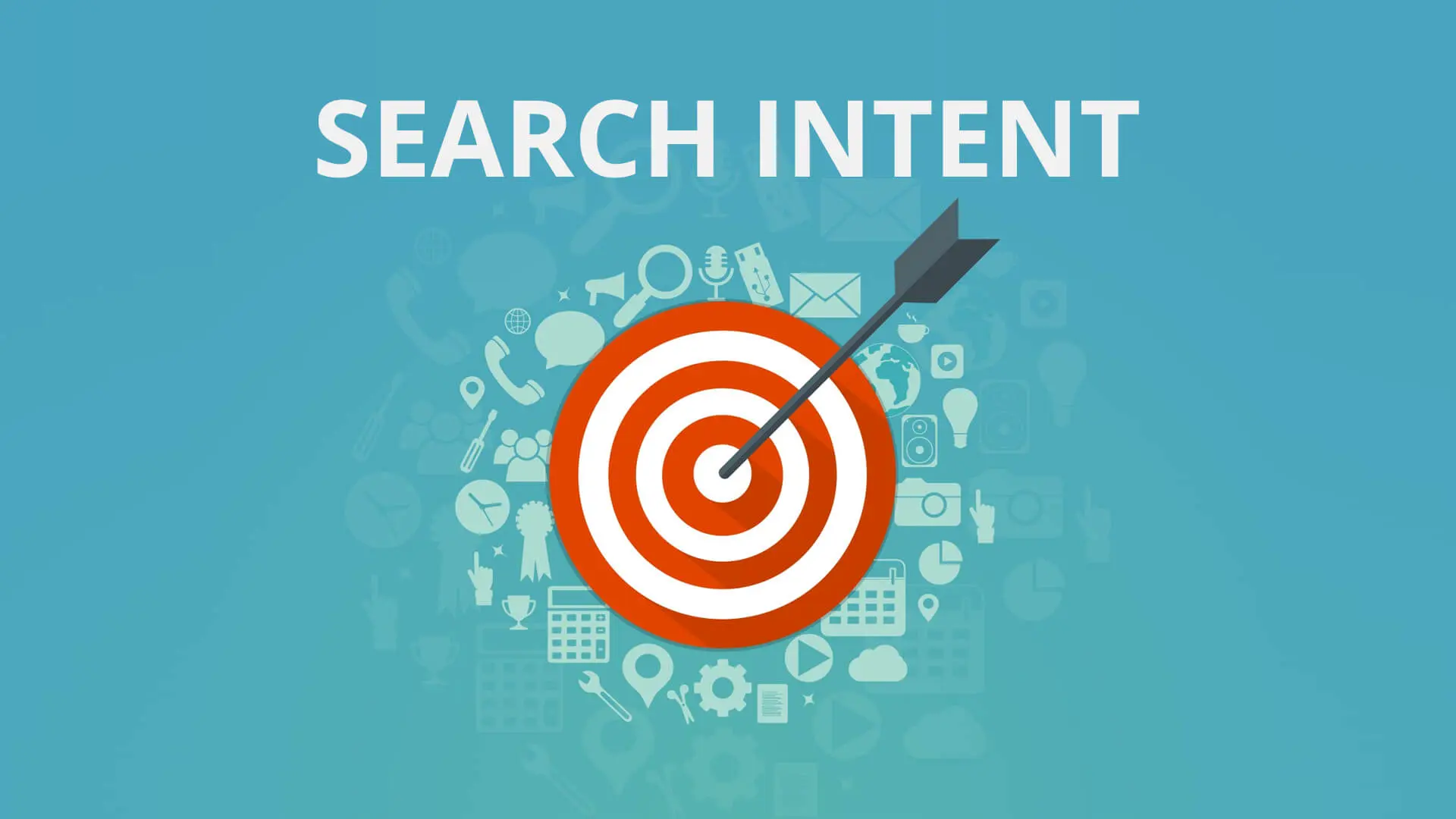
Another way to look at it is that even if keyword research does help people locate your products and services, there’s not necessarily a doubt they’ll commit to a purchase or come back to your website. This is where the ability to determine search intent becomes crucial, prompting visitors to take action.
Look at this guide, where we discuss the basics of keyword search intent and its types (informational, transactional, commercial, and navigational intent); at the end of the guide, we will answer the question, “Is search intent important”. We’ll also help you target and capture the right keywords and build an intent-based keyword list.
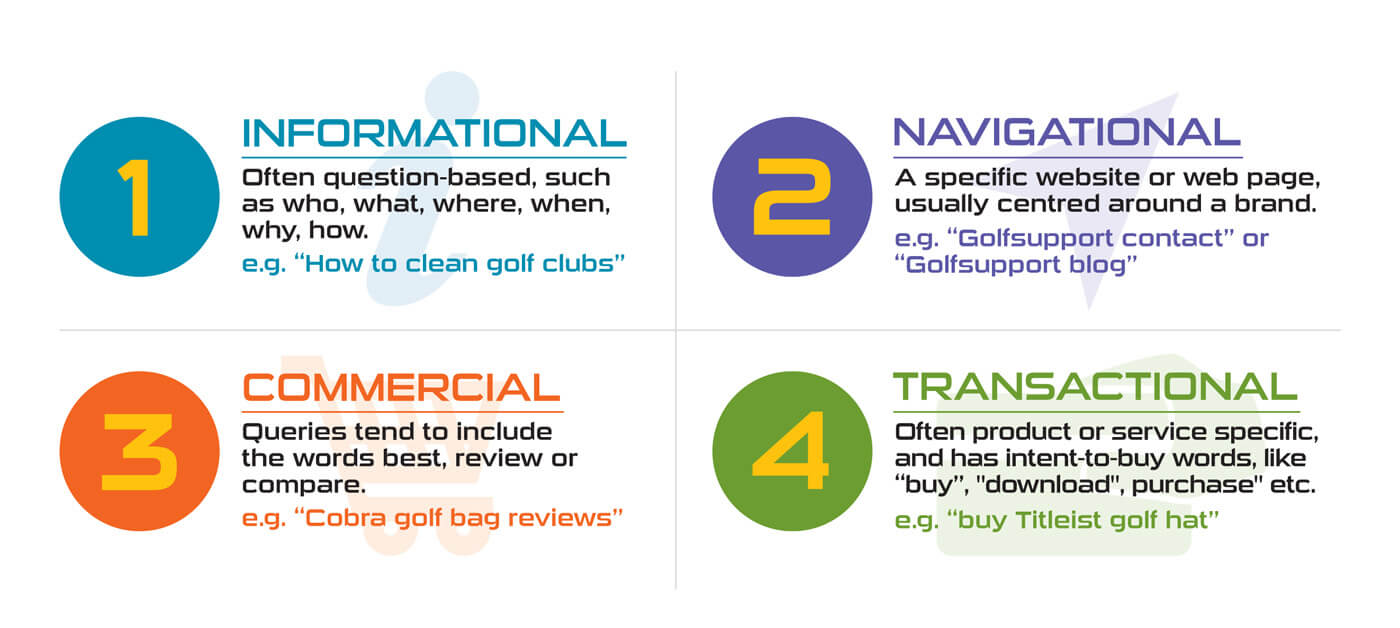
What Is Search Intent in SEO?
Let’s start by referencing a third party’s basic definition of keyword search intent before identifying the common types of search intents. That being said, target search intent surrounds the idea of why a particular search query was made. Or better known as user intent, what was their motive for performing the search?
Grasping search intent is key to enhancing traffic quality, which is precisely why we’ve created this guide for you.
Google will want to know if the person is looking for information, an immediate answer to a question or if they’re to be redirected to a specific website they want to go to. It will also determine if people want to buy the product or service. The different kinds of searches conducted by the user, in turn, play crucial parts in every user journey.
Suppose you need an instant answer; The search engine might serve a featured snippet based on your intent, and the list of results will differ from those displayed when you’re looking for a specific site. The keywords included in the search might be similar in both cases, but the difference in intent determines how Google lists the results, including which website appears as the first result.
To sum up, search engines like Google tend to provide search results – or SERP features based on the relevant keywords and the intent or motive of the search.
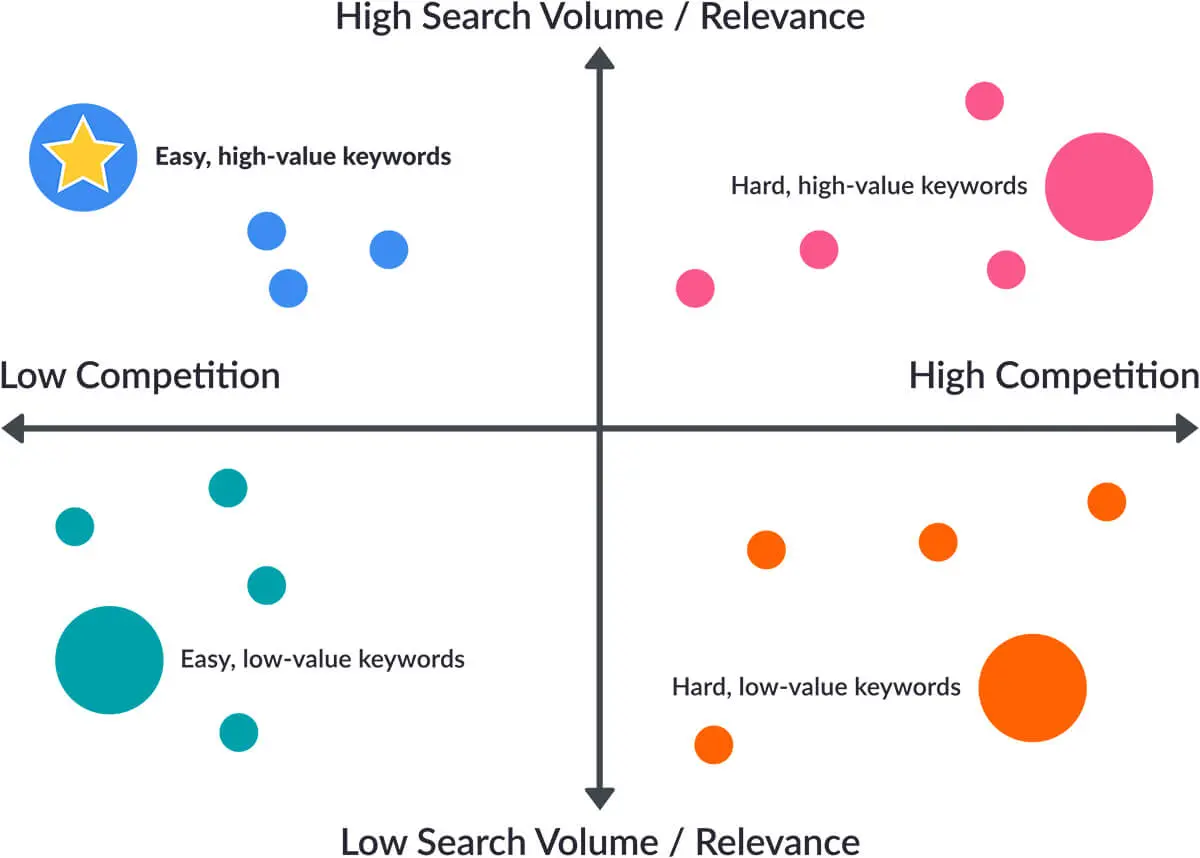
Does Search Intent Matter?
Search intent matters in SEO; after all, Google’s primary focus is to provide you with the most relevant results for your search query. That’s where its success story stems from. You’ll need to focus on creating content for search intent and relevance through keyword research to rank higher in Google’s SERPs.
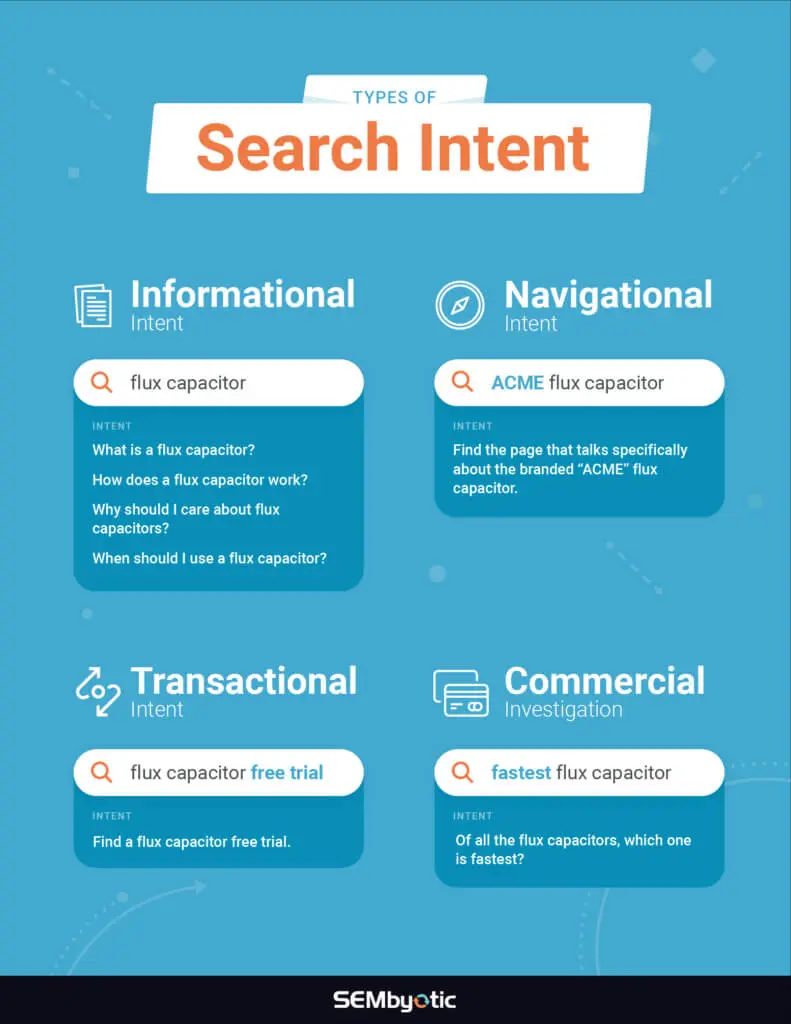
Forcing keywords into your content isn’t the solution for improving your site’s search rankings. Instead, focus on creating relevant content that truly aligns with user search intent. This approach ensures a better user experience and leads to more success in digital marketing. For more insights, check out our guide on keyword usage.
Want to receive updates? Sign up to our newsletter
Each time a new blog is posted, you’ll receive a notification, it’s really that simple.
Types Of Keyword Search Intent
Here, we’ll discuss the various types of intent in keyword searches, starting with the three commonly used types of search intent.
1. Informational Intent
When a user searches for relevant information, that’s called informational search intent. For example, it might just be a brief answer to a simple question or even a deep dive into a broad topic, thereby expecting to learn something more extensive related to HTML, football, the weather or even directions to an airport.
Once a user types in queries like “What is search intent?” or “How do you optimise a website for SEO?” Google begins compiling a list of the top and relevant sites that may best answer these queries.
These long-tail keywords and modifiers (how, what, etc.) used to conduct informational searches are referred to as informational keywords. Initially, they rarely progress to a boost in conversion rates. Instead, they help in identifying the problem and finding a quick solution.
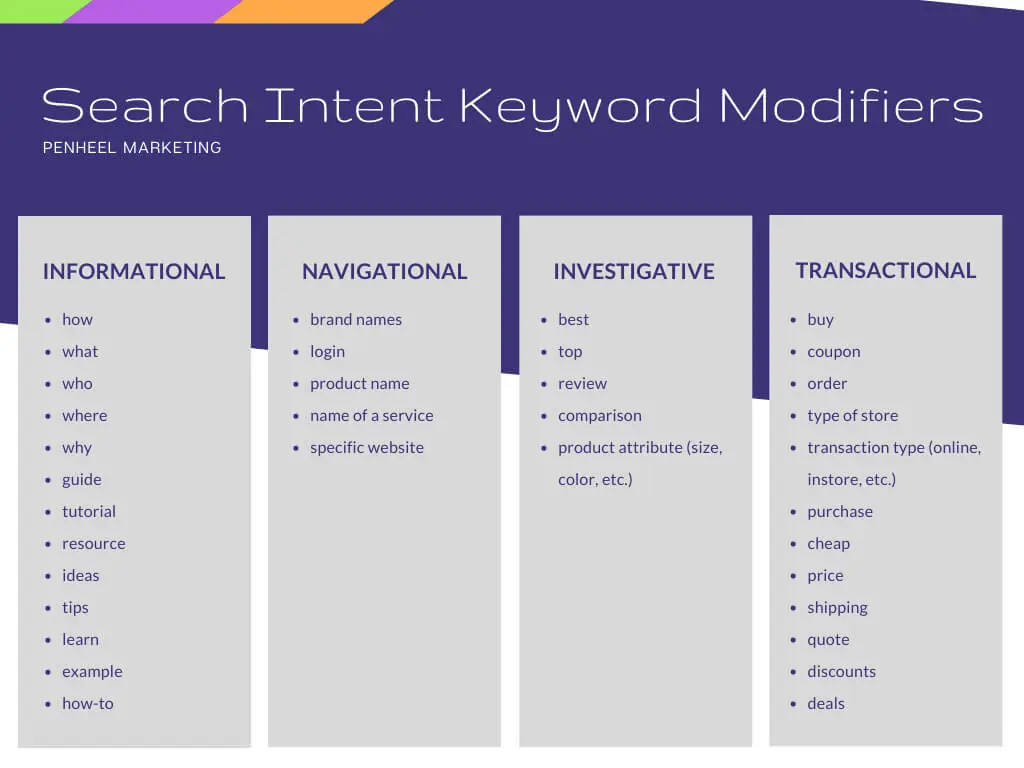
Keeping this in mind, every website should include content, answering a few questions relevant to their business. This will improve local and national SEO rankings and build your brand name, placing the business as an authority in the industry.
2. Navigational Intent
With navigational search intent in place, the searcher uses certain navigational keywords searches a specific website to know which site landing page they want to visit. It would probably be quicker if they typed the website URL on the Google Search bar, but they might not know the exact web address.
For example, if you want to visit social media platforms, you’ll probably conduct searches for Facebook or Twitter. Or suppose you know a few details of a particular Sunshine Coast Web Design agency, including its name, dates, and location. Your search will resemble something like “Web Design Sunshine Coast sitecentre”.
As a result, Google will identify the concert and present you with a list of websites. Your intent behind the search may not be to buy a ticket; you might want to know about the musicians performing or the other important details.
So, like informational queries, navigational intent may not lead to a conversion, but it’s the first step to helping brands build an online presence. Visitors may eventually want to buy something from your website.
3. Transactional Intent
Transactional search intent is when a user conducts a specific search to buy a product or service. Ideally, they already know what they wish to buy. But they might not know where to buy it.
So, optimise your landing page with transactional search intent keywords if you wish to boost your conversion rates and sales. They are also referred to as “buy now keywords” and help enhance eCommerce sales by huge margins.
For example, people searching for products and services with words such as “buy”, “coupon”, “discount”, “free shipping”, and “cheap” in their transactional intent phrases will more likely want to buy them. If you can use relevant transactional intent keywords to make your brand visible to these people, there’s a high chance of a conversion.
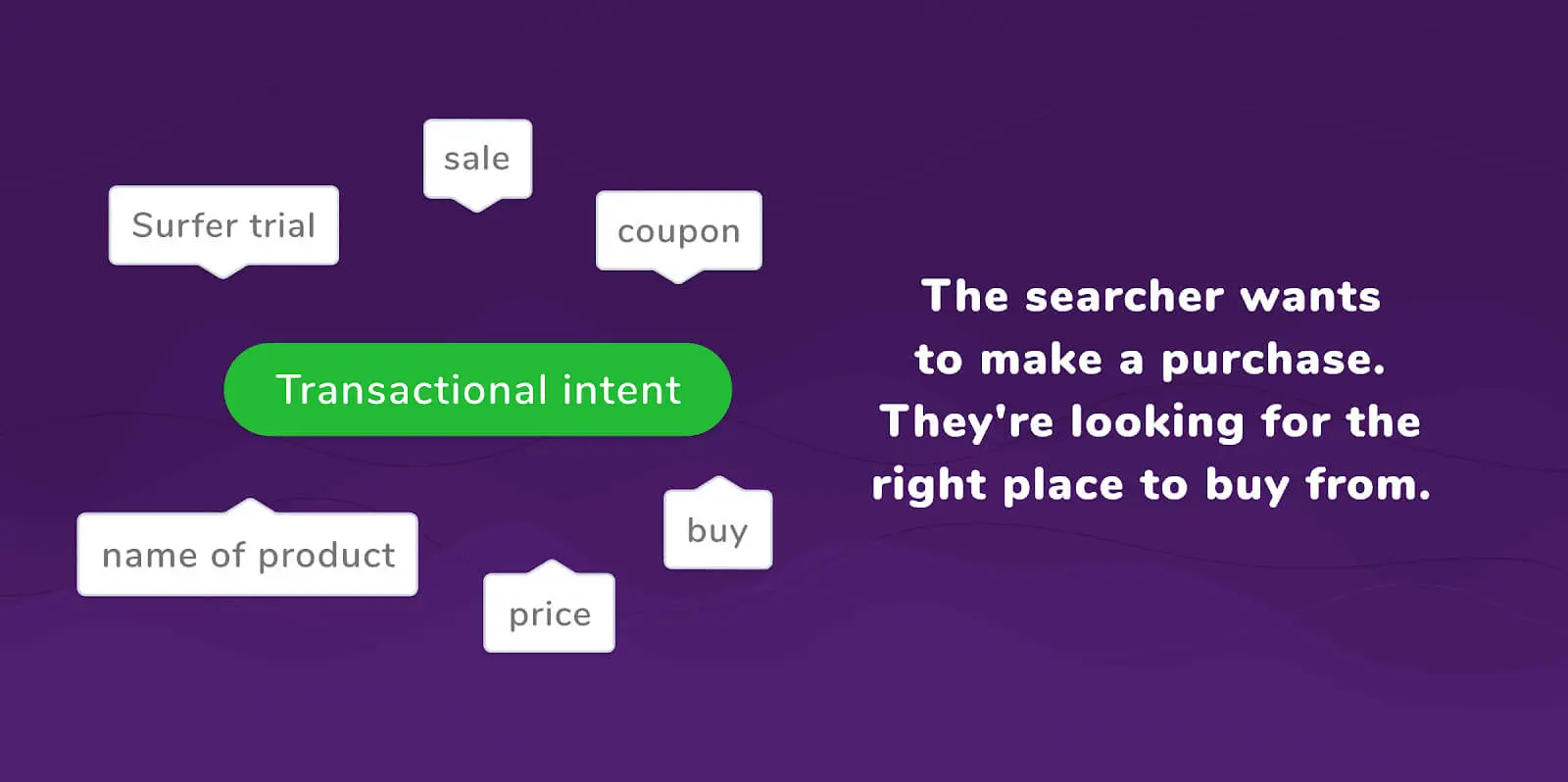
It’s always a good idea to keep the user’s transactional intent in mind to develop your landing page. This will help attract highly motivated searchers and potential customers.
4. Commercial Intent
In most cases, the intent behind a search is to buy something; the user might be looking for information related to the specific product with transactional intent. The combination of transactional and informational purposes is referred to as commercial investigation.
A user who is exploring purchase options but isn’t ready to commit immediately will want to learn more about the options before deciding. They’ll look for customer reviews and compare brands offering the same product or service.
When adequately informed and ready to buy, individuals will be more likely to purchase the product. For example, queries such as “top 10 LED TVs”, “top restaurants near me”, and “best toasters” — are conducted by users’ searches with commercial search intent in mind. They are probably looking for the best option before committing to one.
Capturing The Right Search Intent
As an SEO strategist, understanding user intent and applying intent optimisation is fundamental. This practice helps optimise your site’s content to rank higher in search results and draw in potential customers.
Identify the specific terms people use when they are looking to buy something. Suppose they use words like “buy”, “coupon”, “order”, or “purchase” in their search queries. In that case, it’s a signal that people are looking to make a purchase, indicating a commercial investigation with transactional intent.
On the other hand, users with an informational intent will be conducting searches using modifiers like “how to”, “what is”, “the best way to”, and so on. These users may come back to your website to purchase in the future. So, make sure you develop a content strategy that addresses their queries.
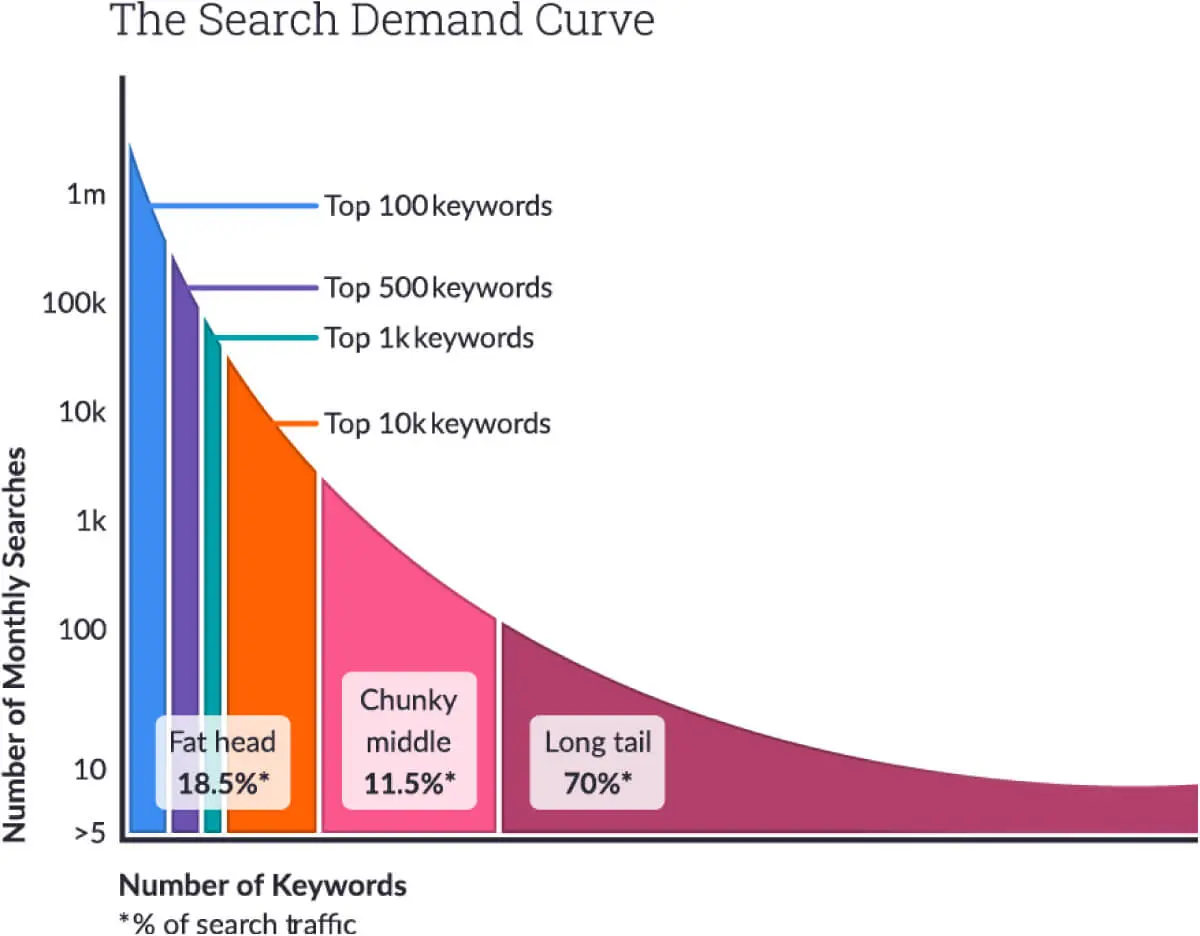
Targeting Search Intent
Ensure you understand your target audience before creating a specific content type, such as a landing page for your website. Those transferring their informational intent into an online search will likely prefer to read a blog post and articles that address their queries. Then again, this type of content wouldn’t be ideal for people to purchase. You must direct them to your product pages by matching search intent.
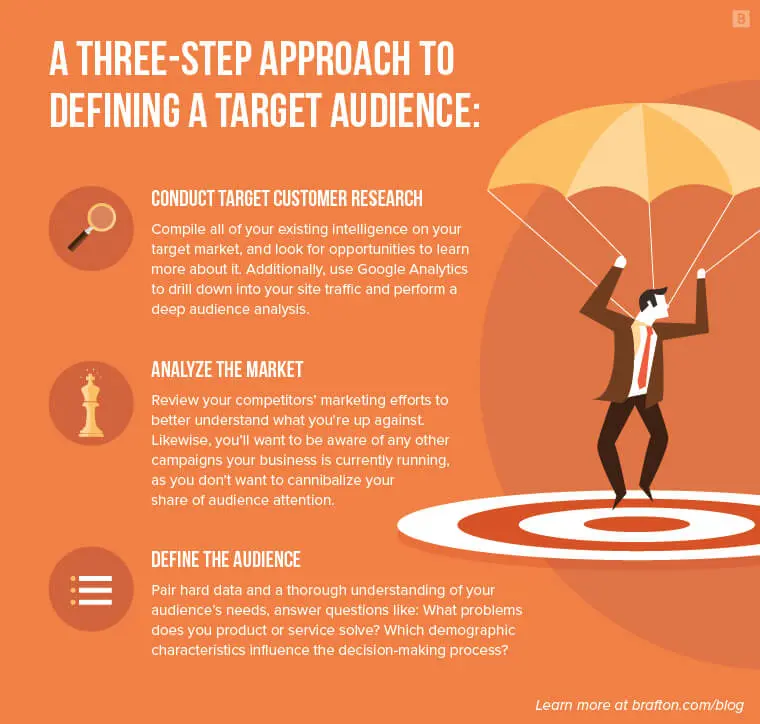
So, for businesses selling furniture, you’ll want the eCommerce website to cover all bases, including “buy a sofa” and “how to choose the best sofa set.” This way, you’ll be attracting users with both transactional and informational intent.
High-Intent Keywords
Even the most well-financed Google ad campaigns can falter without a solid grasp of search intent. However, understanding it can significantly boost your site’s traffic. Check out more on how to optimise with search intent here.
Coming high-intent keywords signify a strong commercial search intent of a searcher to conduct a navigational, transactional, or informational search. Commercial search intent keywords only pertain to transactional queries and can be considered powerful “signals” from promising and potential customers.
On the other hand, low-intent keywords can be either informational or navigational. The commercial or transactional intent of this type of search is relatively low. People using these keywords may not be looking or planning to buy a product; however, you can use them to drive organic traffic to your website pages.
That said, there are two types of commercial intent keywords — “product” and “buy now” keywords. Of all the “buy now” keywords, “buy” has the highest intent as it signifies the strongest intentions of people willing to make a purchase.
Even “product” keywords, such as “cheapest”, “review”, “best”, “top”, and “comparison”, indicate a commitment to purchase. The terms “review” and “comparison” may not appear strong; they can still lead to a conversion. However, you might have to work harder for the conversion as an SEO strategist and advertiser.
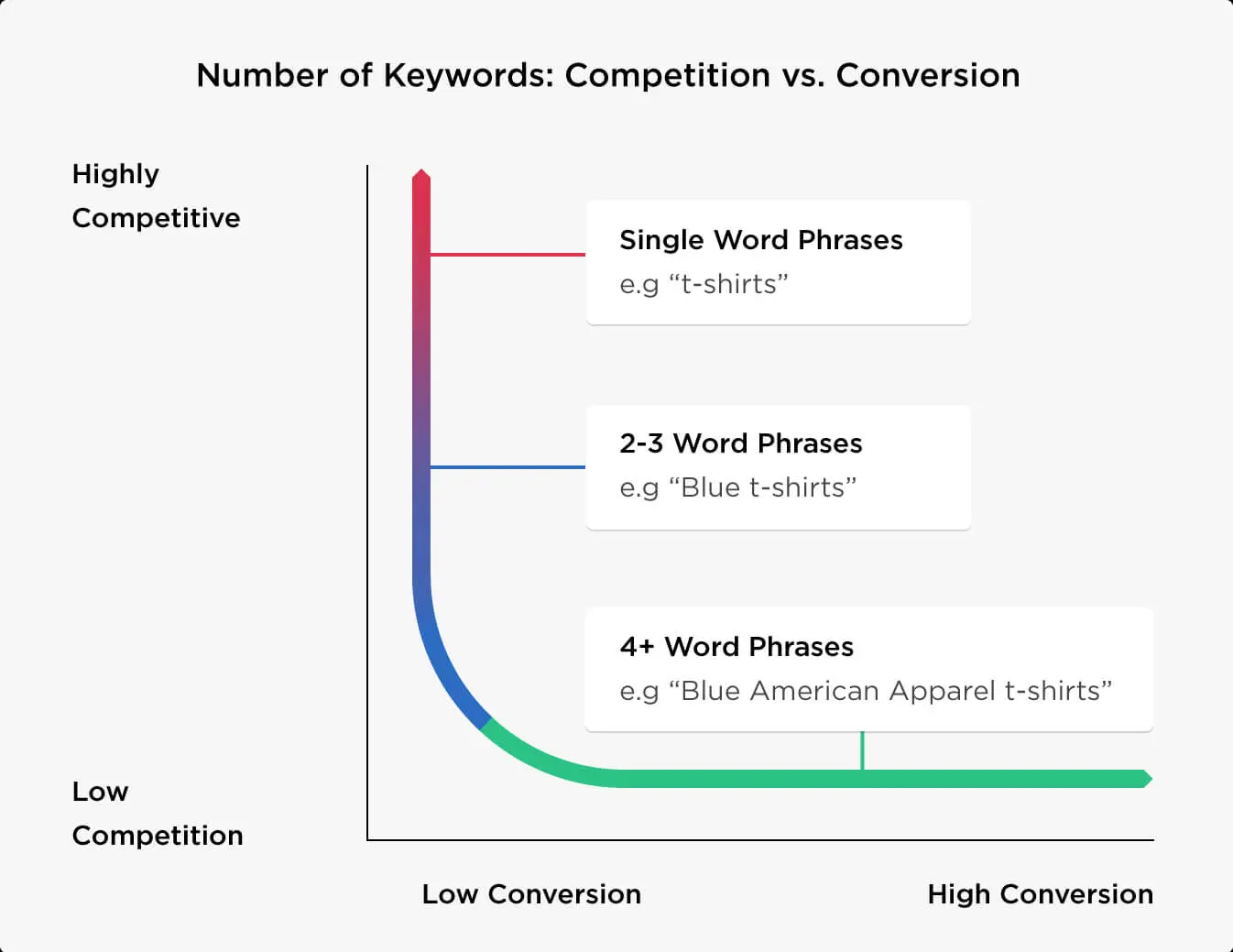
On the contrary, keywords specific to the product and branded searches, being comparatively more competitive, improve SEO rankings and convert significantly well.
Identifying High-Intent Keywords
Using WordStream Advisor to identify relevant high-commercial intent keywords that will work for your business is a good idea. This tool can also specify negative high-intent keywords and recommend some of the best ways to optimise ad text to boost conversion rates and reduce unnecessary expenses.
Keyword Search Intent And Keyword Research
Businesses conduct keyword research and optimise for search intent so that their SEO rankings SEO rankings are higher in Google SERPs; in turn, it allows their products or services to be easily found by target audiences to satisfy user intent to be seen on the search result pages. That’s a great way to kickstart any company’s content marketing campaign.
After all, website content and blog posts lacking relevant keywords related to the particular business won’t capture a suitable position in the search results pages. Ensure you produce quality content and use a robust keyword research tool like Google Keyword Planner and Ahrefs. These will help keep track of the target keywords with high search volumes and lower competition.
However, it’s a bit more challenging to outrank big and reputable brands, so you’ll have to search for long and short-tail keywords. Finally, you can use tools like Google Analytics to see how your site performs compared to competitors using similar keywords.
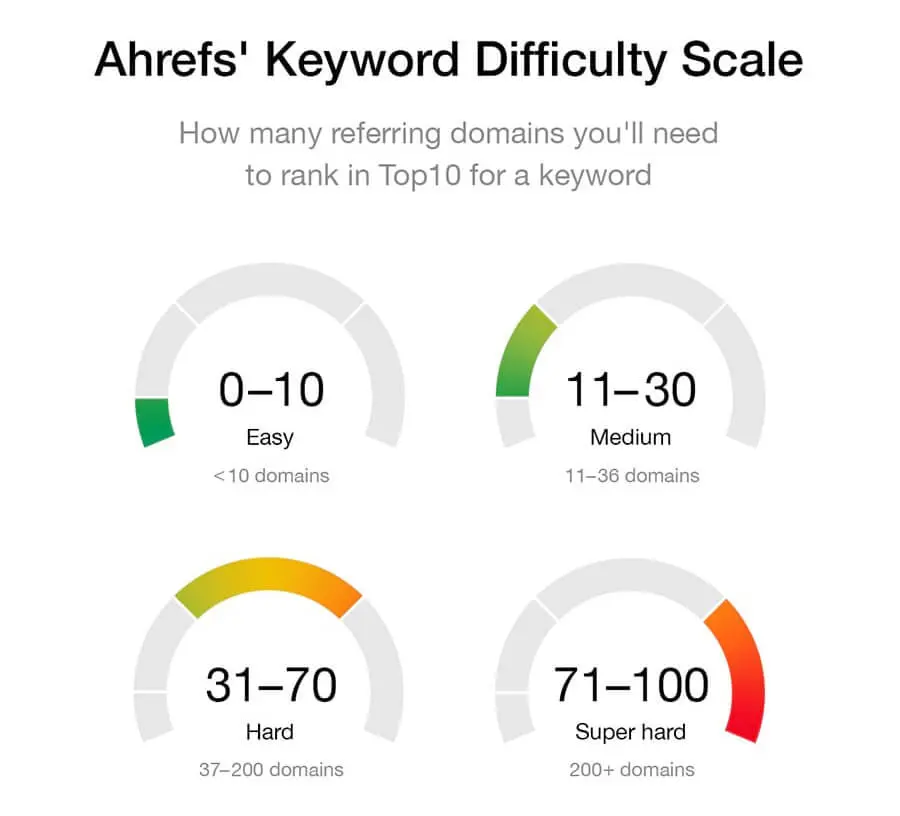
How To Build Intent-Based Keyword Lists
Before you determine your audience’s search intent or even create content surrounding it, you’ll need to build a list of intent-based keywords to optimise your content. Once the list is made, it needs to be intent-based, and you need to add “modifiers” which signify the purpose or intent behind the search query.
As mentioned, tools such as Google Keyword Planner, Answer The Public, Ahrefs, UberSuggest, and Google Search Console can help identify the core keywords. Just make sure you refrain from using auto-generated keyword lists.
You could also go to Google’s “people also ask” box after typing a few of these keywords in the search bar. The questions included in the “people also ask” section can be added as intent-based keywords on the list.
However, it’s essential to remember that keywords vary based on your location and language. For example, the spelling and choice of words differ for people living in America and Australia. As a result, the specific keywords used in both regions might vary. For example, “sweater” is known as “jumper” in Australia, while “optimisation” is spelt as “optimisation” in the US.
So, if you wish to capture the international market, you’ll have to target the keywords of both areas accordingly. Once your keyword list is ready, add suitable modifiers, depending on the intent. For informational queries, you’ll want to focus your content surrounding searches like “What is (product)?” and “How does (product) work?”
On the contrary, transactional queries should centre around words like “sale”, “low cost”, and so on. You can also try to be more specific while conducting keyword research. If you sell clothes, such as jeans, colour-based keywords like blue, black, grey, etc., and size-based keywords like small, medium and large can be used to attract the target audience.
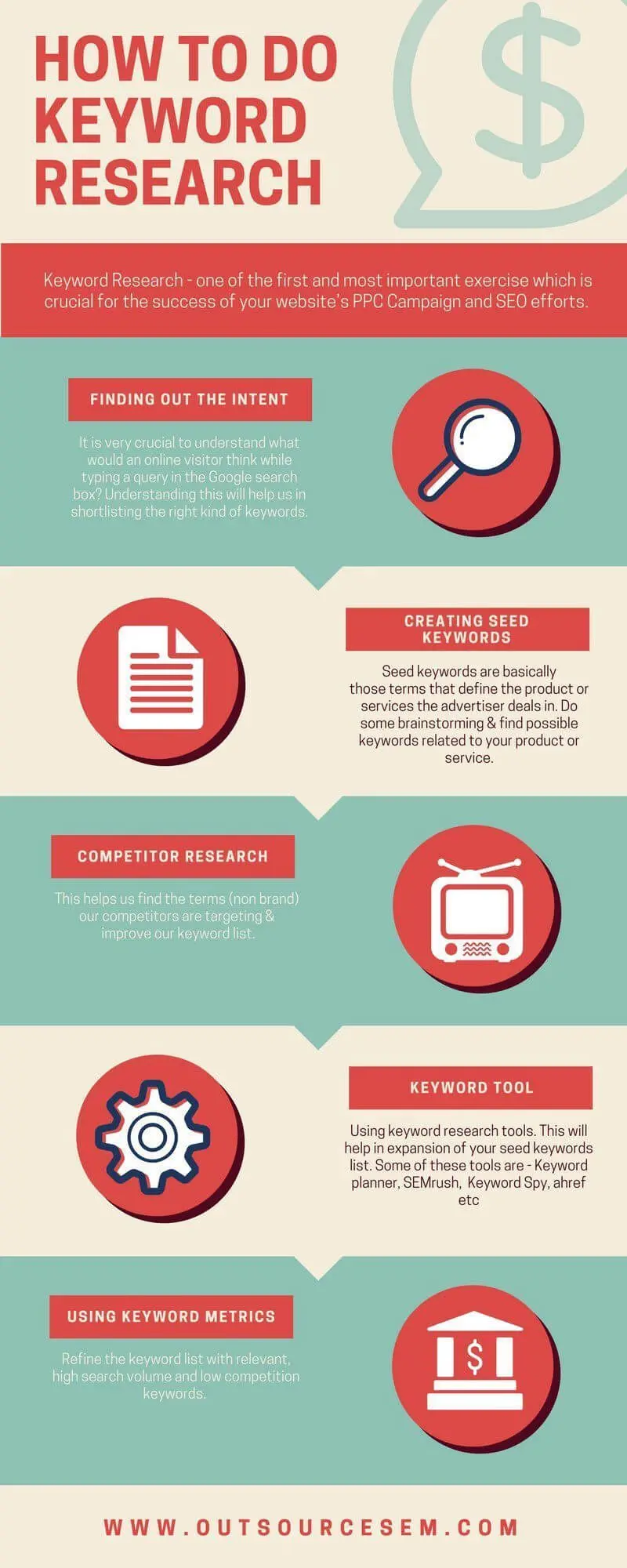
Final Thoughts on Keyword Intent
The first step to building a successful content marketing campaign is creating a list of keywords based on the purpose of the search. Once that’s done, you’ll have to shortlist the ones to keep based on search volume, relevance, ranking opportunity and competition.
It’s better to opt for high-intent keywords; by using them, the searcher makes their intention of buying the product transparent. They are also more cost-effective, saving you from wasted expenditure and helping boost conversion rates.
You must choose a suitable advertising format to attract searchers with commercial or transactional intent.

